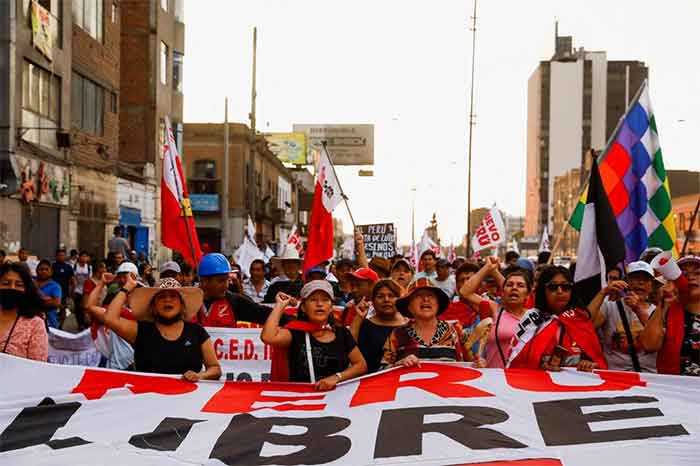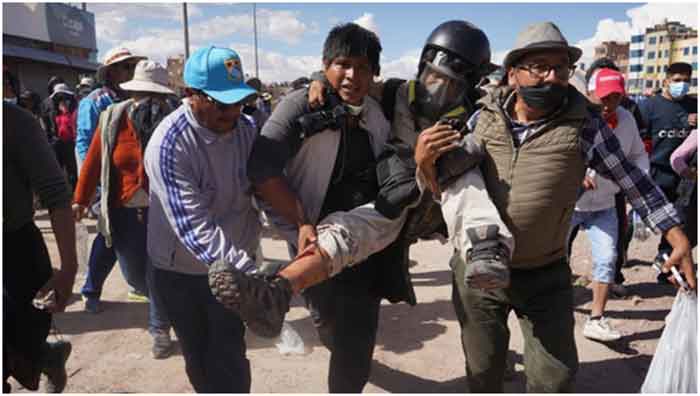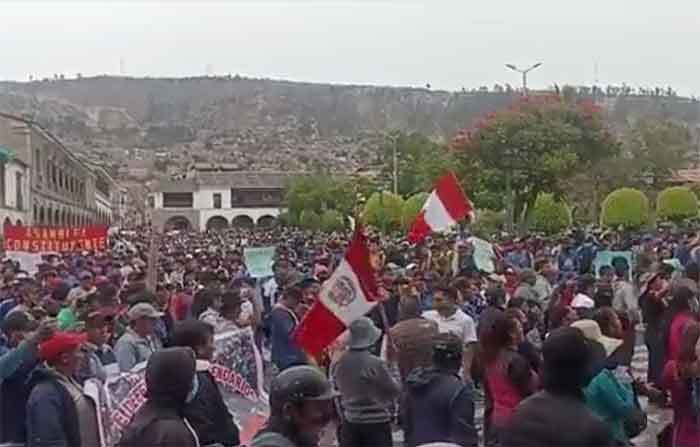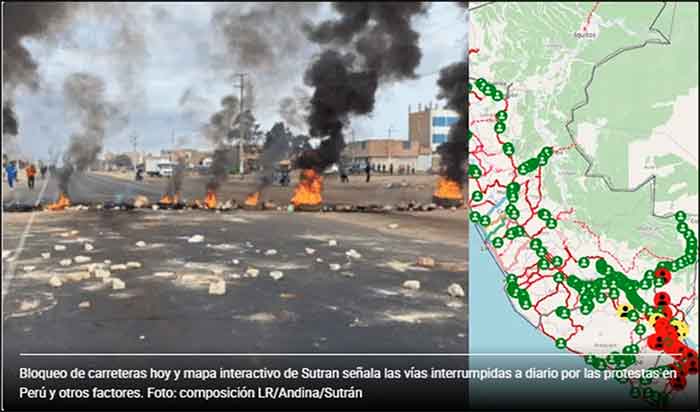
Protests are continuing in Peru even 11 weeks after the ‘coup’ of December 7, 2022, dislodging President Pedro Castillo and putting him under arrest. Formally elected president Pedro Castillo was in office for a short period: 28 July 2021 – 7 December 2022. Newspaper La Republica, which belongs to one of the two biggest media houses, ran two headlines carried photographs online on February 21, 2023: «Road Blocks Today, which roads will remain closed and « Live — March of Protesters in Lima and in regions, while in print version a page warned against ‘indiscriminate use of force’ against protesters. Till date at least 60 people died by police attacks on protesters and hundreds were wounded; from tear gas shells to firing live ammunitions from helicopters, the govt forces used variety of methods.
Regions outside the capital city Lima, in general, are more active in the protests, the tourist attraction ‘Inca Trail’ including the Inca Rail and tour to Machu Picchu was closed several times and for a long period, tour operators of rich countries were till recent times issuing warning notice for visiting interior places of Peru. Lima also saw eruption of protests, in academic institutions and in other places too. In January 2023 four marches from for regions tried “Toma La Lima” or takeover of Lima and thousands participated outside and inside Lima. From south of Peru thousands of indigenous people were reported to be marching on Jan 17 towards Lima to help the protesters. They were raising the demands that are popular now: Resignation of President Dina Boluarte, dissolution of the Congress, arranging convocation of a constituent assembly and immediate release of Pedro Castillo. [https://www.jornada.com.mx/notas/2023/01/17/mundo/miles-de-indigenas-siguen-marcha-hacia-lima-para-apoyar-manifestaciones/] Protesters also tried to take over an airport and stop its operation.
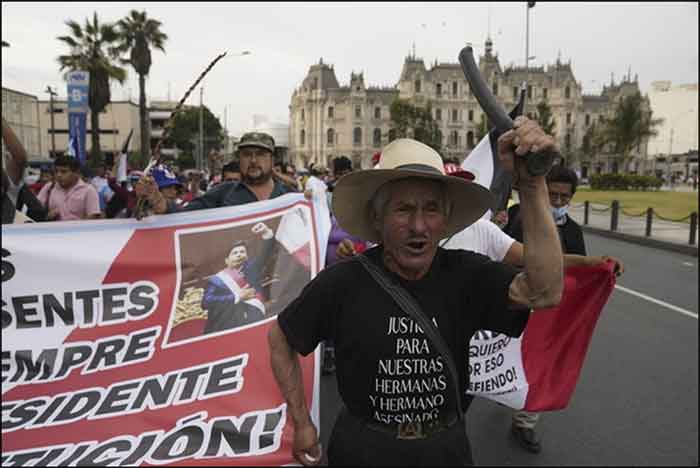
INDIGENOUS PEOPLE MARCH TOWARDS LIMA
Lima, or rather Metropolitan Lima, is the urban sprawl where one third of the population of the country lives! About or more than 35% live in slums. Lima is the main industrial and financial centre of Peru, most probably producing two-third of the industrial products. Lima also saw death of protesters – on January 28, Saturday, Víctor Santisteban Yacsavilca was wounded fatally, rushed to the hospital but did not survive (https://elpais.com/internacional/2023-01-29/la-represion-policial-cobra-su-primer-muerto-en-lima.html); police also attacked inside university – on January 21 in the morning, 09:30 hours local time, police entered the premises of Universidad Mayor de San Marcos (UNMSM) and detained 200 students inside the campus – an act showing utter highhandedness, and the way more than 400 strong police force kept 200 students detained –which was criticized even by the representative of the European Union, the professors and alumni criticized severely too, and voices crying for resignation of the rector was also heard (https://www.eldebate.com/internacional/20230121/policia-peruana-desaloja-manifestantes-universidad-lima-detiene-200-personas_87818.html; https://www.infobae.com/peru/2023/01/23/alumnos-maestros-y-egresados-de-san-marcos-exigen-renuncia-de-jeri-ramon-por-intervencion-policial-en-la-universidad/).
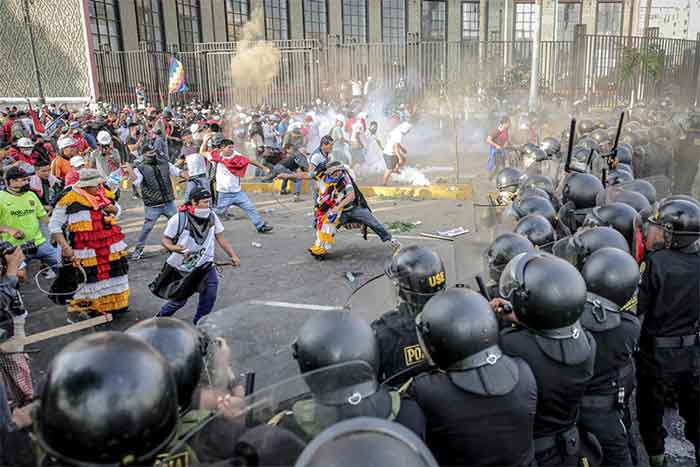
CLASH INSIDE UNIVERSITY
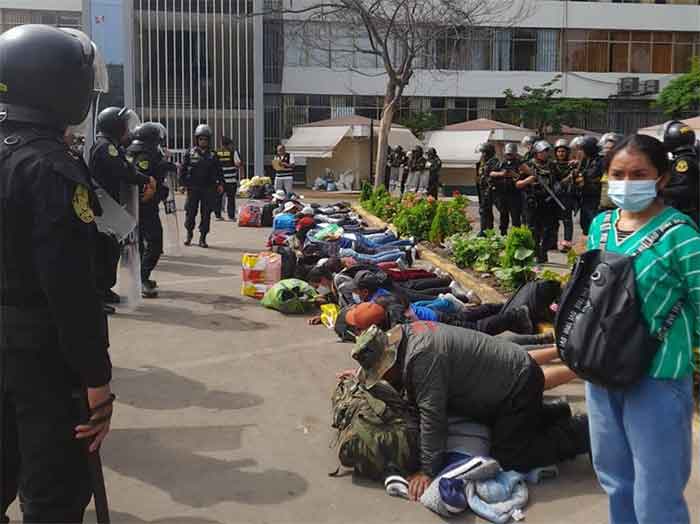
DETAINED STUDENTS
Metropolitan Lima is now under State of Emergency due to protests since Feb 2, 2023 which will continue for 45 days as per latest notification. [https://busquedas.elperuano.pe/normaslegales/decreto-supremo-que-prorroga-el-estado-de-emergencia-en-lima-decreto-supremo-no-025-2022-pcm-2049465-3/].
Social scientists at ‘Instituto de Estudios Peruanos (IEP)’ researching with public opinion for long time, while giving their report card of January, warned the rulers in Lima in a peculiar way: the first chapter said: No es solo el sur, or it is not only the south – that is up in protests, the second chapter was titled: Protestas en el país i.e., protests all over the country and they gave detail; the third chapter must be very irritating for the rulers, its title was: A un mes del golpe de Estado, i.e., of one month after the coup d’etat! (https://iep.org.pe/wp-content/uploads/2023/01/Informe-IEP-OP-Enero-I-2023.-Informe-completo-version-final.pdf) Though the methodology or randomness of the survey can be questioned by expert statisticians or demographers quantitatively, we may get some glimpses of public opinion from it after all in qualitative terms. And from the public opinions as collected by the social scientists of IEP we can have premises which we shall be able to connect in the discussions as regards WHY a large section of the Peruvians are protesting and WHAT actually they want us to look into.
Opinions
In December 60% people felt protests were justified; in January 50% felt themselves identified with the protesters; and 30% felt blocking highways and roads by protesters are justified.
60% of the people feel that ex-president Pedro Castillo must be freed; 71% disapprove Dina Boularte taking position of President of the republic.
69% of the people want a Constituent Assembly (that writes a new constitution) – 67% of urban people and 78% of rural people; 86% feel that the present Congress should be dissolved. Nearly three-fourth of people surveyed would not have minded if ex President Pedro Castillo himself had issued call for Constituent Assembly.
What kind of constitution would be better? 51% approve that the govt should own major industries; 74% think: practice of hire-and-fire by private companies should be restricted.
(However, regarding legalizing abortion or same-sex marriage, most people are still holding that view which Pedro Castillo also hold – they are against these.)
Anyway, the opinion poll did not raise some important concerns, some of which we shall see later. But one need to be mentioned here:
Many Peruvians, % of them not counted by any agency, demand immediate release of Pedro Castillo, the first ordinary man to become a president of the republic.
Protest — Reasons
There is no reason to think that Pedro Castillo and his party Perú Libre was leftist (or even Marxist, as told by ‘left’ pundits like Vijay Prasad and printed in the CPIM organ), though such misinformation was widely spread by many ‘left’ intellectuals; for detail rebuttals, with authentic info and data readers may see a short article Peru under Pedro by this author that was published in Frontier Weekly (https://www.frontierweekly.com/articles/vol-54/54-21/54-21-Peru%20Under%20Pedro.html). His political advisor was Veronika Mendoza of Nuevo Perú, a party which at best can be called a little eco-socialist which says, ‘recognizing the country as megadiverse does not signify negating mining’ and calls for sustainable management of resources! (Programa del Movimiento Nuevo Perú, 2017, https://nuevoperu.pe/propuesta) His economic advisor was Pedro Francke whose articles in his own website cannot perhaps place him even as a market-socialist (Francke, Pedro (2021): “Nuevos Rumbos en la Economía: ¿Por Dónde?” https://pedrofrancke.com/2021/06/12/nuevos-rumbos-en-la-economia-por-donde/) Even if Perú Libre and its President sometimes talked about agrarian reform, actual program of the government was very much insignificant and then also the govt did not show much vigour in this direction. At a crucial juncture the Perú Libre party asked the president to resign from its membership and Pedro Castillo resigned – he was not at all a long time member of that party. There were many confused steps of reshuffling of ministry, some of which were imposed upon him. All these were dealt thoroughly by Francisco Dominguez in his article in Counter Currents ‘Golpe in Peru: Castillo under arrest, people demand a constituent assembly’, a must read article (https://countercurrents.org/2022/12/golpe-in-peru-castillo-under-arrest-people-demand-a-constituent-assembly/).
Pedro Castillo in his youth was an activist of Rondas Campesinas, an organisation of semi-militia type, which in the 1980s and 1990s primarily kept watch so that the Shining Path (Sendero Luminoso) guerrillas cannot get control over rural areas in general (to deter its spread) (https://jacobin.com/2021/06/pedro-castillo-peru-libre-keiko-fujimori-runoff-election-june-6-neoliberalism). And during the time of crisis as president he called his friends of Rondas Campesinas to stand by him. Some senior peasant representatives of Rondas visited the presidential palace and discussed issues (https://elcomercio.pe/politica/pedro-castillo-intenta-ampararse-en-las-rondas-campesinas-pero-tambien-recibe-criticas-noticia/). The topmost leader of Sendero Luminoso more known by the name ‘Chairman Gonzalo’ was captured by govt forces on September 1992 and he died while imprisoned, in a navy base, on September 2021, at the age of 86. That time Pedro Castillo was president.
However, the overwhelming majority of the Congress and the ruling class was bitterly against Pedro and could not reconcile to the fact the Pedro, a peasant, a primary school teacher would be the President, a post always held by the Elite (except days under military rule). The Fujimorist party was from the beginning trying to dislodge the govt and continue their own rule. The organs of the state – bureaucracy, judiciary, military and all directly or indirectly, de facto, backed the arch right.
Francisco Dominguez in his above mentioned article in Counter Currents ‘Golpe in Peru: Castillo under arrest, people demand a constituent assembly’ put it an exemplary illuminating way very succinctly, “This would explain the paradox that right-wing hostility to president Castillo, unlike other left governments in Latin America, was not waged because Castillo was undertaking any radical government action. In fact, opposition to his government was so blindingly intense that almost every initiative, no matter how trivial or uncontroversial, was met with ferocious rejection by Peru’s right-wing dominated Congress. The Congress’ key right-wing party, was Fuerza Popular led by Keiko Fujimori, daughter of Peru’s former dictator, Alberto Fujimori. In Peru’s Congress of 130 seats, Castillo counted on 15, originally solid, votes from Peru Libre, and 5, not very solid, votes from Juntos por el Peru. In the absence of government mobilization of the masses, the oligarchy knew Castillo represented no threat, thus their intense hostility was to treat his government as an abhorrent abnormality sending a message to the nation that it should never have happened and that would never recur” (italics by this author).
But then why the country erupted in protests? Let us see two or three major issues.
«RPP (Radio Programas del Perú) carried a description titled Voices of the Rondas Campesinas. (https://rpp.pe/peru/actualidad/vocero-de-las-rondas-campesinas-nos-sentimos-decepcionados-de-un-congreso-incapaz-de-entender-las-demandas-del-pueblo-noticia-1400712) It was on 21 April 2022. They said that they were deceived by the Congress and came marching to voice their demands to the government of Pedro Castillo: Do that what should have always been done in the last 30 years. To remind Castillo of the election promises: the Second Agrarian Reform, Fight Corruptions and arrange for a Constituent Assembly. Demand for Agrarian Reform was voiced several times, including in a march of 10 thousand peasants in August (https://caretas.pe/politica/video-mas-de-10-mil-ronderos-participaran-en-la-marcha-nacional-programada-para-el-9-y-10-de-agosto/). And even Pedro Castillo officially invited the Rondas in November to discuss agrarian reform which was notified in govt website (https://www.gob.pe/institucion/presidencia/noticias/566902-presidente-pedro-castillo-convoca-a-rondas-campesinas-para-impulsar-segunda-reforma-agraria-y-luchar-contra-la-corrupcion). However, demands for a revolutionary land reform the way it was done during the days of José Carlos Mariátegui about a century ago was not audible. Yet, distribution of land in more skewed than many other countries.
A good amount of land reform took place during the military dictatorship period of ‘Revolutionary Government of the Armed Forces’, particularly during the period led by Juan Velasco Alvarado (1968-75). But in the Fujimori era of 1990s neoliberal attacks heightened to a great extent the spontaneous concentration of land that always take place when commodity, money, market are the categories which, it may be said, actually rule. From then on, concentration is rapidly increasing.
Table 1. Distribution of Agricultural Landholdings in Peru
| Size of farm (Ha) | Producers | Area | ||
| Number | Share (%) | Number (ha) | Share (%) | |
| Without land | 47,467 | 2.10 | 0 | 0.00 |
| < 0.5 | 507,137 | 22.43 | 99,700 | 0.26 |
| 0.5 to 1 | 324,706 | 14.36 | 204,933 | 0.53 |
| 1 to 5 | 922,572 | 40.80 | 1,964,119 | 5.07 |
| 5 to 10 | 218,564 | 9.67 | 1,418,311 | 3.66 |
| 10 to 15 | 81,937 | 3.62 | 595,696 | 1.54 |
| 15 to 20 | 36,337 | 1.61 | 595,696 | 1.54 |
| 20 to 100 | 98,798 | 4.37 | 3,692,042 | 9.53 |
| > 100 | 23,455 | 1.04 | 29,841,281 | 77.02 |
| TOTAL | 2,260,973 | 100 | 38,742,465 | 100 |
Source: Based on INEI, VI Censo Nacional Agropecuario 2012 [World Bank, 2017]
The above landholding data is of 2012, and the present scenario is, most likely, worse.
It may seem that a revolutionary land reform is the only solution left in face of such inequality – where only 1.02% holding had 77.02% land, each more than 100 Ha, whereas, 38.89% landless and marginal peasants got only 0.79% land, and about 40% small farmers (here 0-5 Ha) had only 5% of the total land.
But in governmental talks there were repeated assurances there there would be no expropriation of land (https://www.europapress.es/internacional/noticia-castillo-lanza-segunda-reforma-agraria-peru-remarca-no-busca-expropiar-tierras-afectar-derechos-20211004030637.html; https://elcomercio.pe/peru/cusco/en-vivo-siga-las-incidencias-del-lanzamiento-de-la-segunda-reforma-agraria-desde-cusco-noticia/; https://www.jornada.com.mx/notas/2021/10/04/mundo/anuncia-castillo-segunda-reforma-agraria-en-peru/ and etc) Perhaps the cautious non-revolutionary way would be purchasing land from landlords to distribute among landless, or setting a ‘land ceiling’ high enough that big landowners will not disapprove much. (In contrast Mariátegui’s program [“Programa del Partido Socialista Peruano” in Mariátegui, José Carlos eds. “La organización del proletariado, Comisión Política del Comité Central del Partido Comunista Peruano, Lima. Ediciones Bandera Roja, 1967. https://www.marxists.org/espanol/mariateg/1928/oct/07a.htm] talked about — providing latifundio lands to the communities for distribution among their members in sufficient proportion for their needs.)
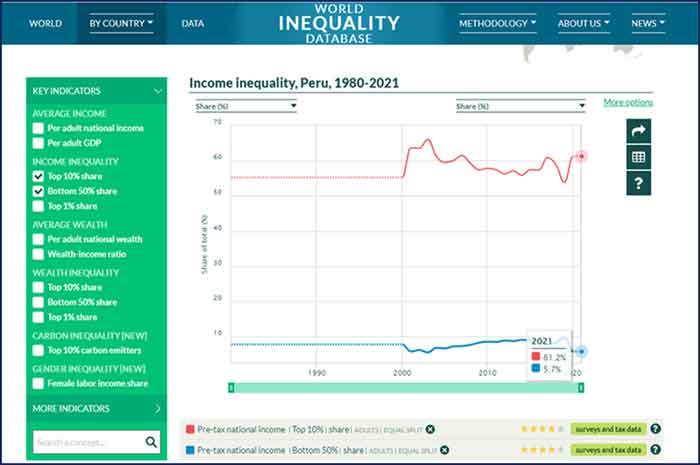
PERU INEQUALITY
«Inequality is another curse – according to INFOBAE Peru is one of the four most inequal countries of the world (https://www.infobae.com/peru/2023/02/06/peru-es-el-cuarto-pais-con-mas-desigualdad-en-el-mundo/) the other three being Mozambique, Central African Republic and Dominican Republic. The World Bank already in 2020 August warned that the COVID crisis had increased inequality in Peru (https://www.bancomundial.org/es/news/press-release/2020/09/08/crisis-por-el-coronavirus-aumento-las-desigualdades-en-el-peru). In 2021 top 10% got 61.2% of the total income whereas bottom 50 got only 5.7% of total income (https://wid.world/country/peru/). How tolerance are the people regarding inequality? OXFAM report says 47% find it unacceptable (https://peru.oxfam.org/encuesta-nacional-percepcion-de-desigualdades-ENADES2022).
«In a news item dated Nov 17, 2022, we get “Peru has become the most food-insecure country in South America, according to the UN’s Food and Agriculture Organization, FAO. (https://news.un.org/en/story/2022/11/1130737) In addition to the price hikes of food and energy, FAO points out that government mismanagement, poor dietary habits, and an over-reliance on imported food staples and fertilizers are additional causes of Peru’s food crisis. Imported chemical fertilizers cost up to four times what they did a year ago, forcing farmers to reduce their use. The fear is that this will likely impact food production in the coming months and aggravate existing vulnerabilities in Peru.” (Italics by present author)
What Next
In the meantime, by some press reports, in mid-January the Peruvian govt had asked the Congress to permit entry of foreign military inside Peru’s land (https://www.infobae.com/peru/2023/01/20/gobierno-peruano-pide-autorizar-el-ingreso-de-personal-militar-extranjero-al-pais-todos-los-detalles-sobre-esta-solicitud/), who will likely be used to fight rebels in case some anti-govt rebellion springs up. On the other hand, foreign players are naturally keen to grab Peru’s natural resources as much as possible (https://mronline.org/2023/01/10/peru-and-capitalist-extraction-the-imperial-mining-powers-behind-the-throne/).
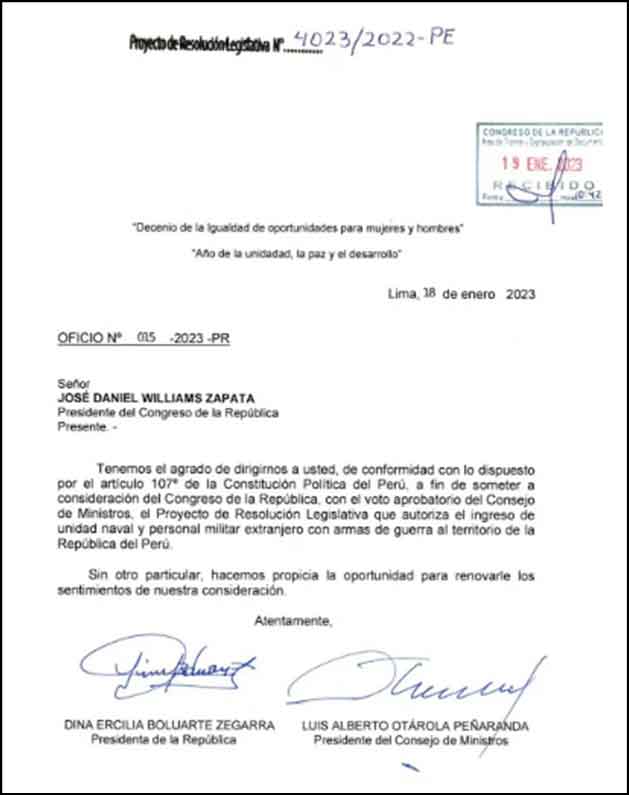
Govt Authorises Use of Foreign Military – courtesy INFOBAE
It is to be seen what happens in Peru, though, in absence of revolutionary fight back against the system even in a visibly small scale, a parliamentary ‘solution’ might come out, but it would be unwise to predict anything.
Sandeep Banerjee is an activist who writes on political and socioeconomic issues and also on environmental issues. Some of his articles are published in Frontier Weekly. He lives in West Bengal, India. Presently he is a research worker. He can be reached at [email protected]

